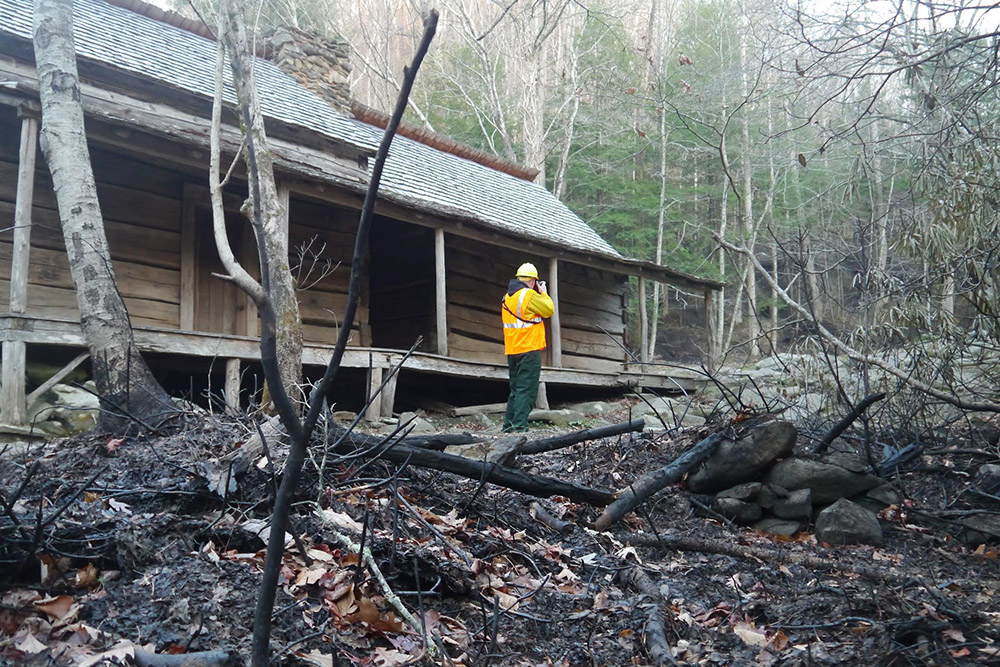Displaying items by tag: wildfire
2016 Smokies wildfires: Six years later, the good and the bad come into focus as natural recovery continues
 Journalists and park officials document damage from the November 2016 wildfires that killed at least 15 people and left hundreds of dwellings and businesses in ruins. Thomas Fraser/Hellbender Press via Knoxville Mercury
Journalists and park officials document damage from the November 2016 wildfires that killed at least 15 people and left hundreds of dwellings and businesses in ruins. Thomas Fraser/Hellbender Press via Knoxville Mercury
How the 2016 Great Smoky Mountains National Park wildfire affected salamanders and other life, six years on
GATLINBURG — The disastrous Chimney Tops 2 wildfire of 2016 occurred some six years ago, but researchers are still looking at its ecological effects.
The Discover Life in America 2023 Colloquium brought together researchers this month from different fields and universities to present findings on research in Great Smoky Mountains National Park.
Researchers presented on many topics, ranging from trout to the history of the Mingus family in the park.
One such presentation, the first of the day, from William Peterman, associate professor in wildlife ecology and management at Ohio State University, focused on the effects wildfires had on salamander populations, which he described as negative.
Other presenters touched on the wildfire’s effects as well, including its effects on vegetation and its beneficial effects on the diversity of bird species.
“Smoky Mountains is the self-proclaimed salamander capital of the world,” Peterman said. He focused his study on the plethodontid family of salamanders, which breathe through their skin.
“Kind of think of them as a walking lung,” he said.
ORNL researcher models fire’s growing footprint in a changing climate
 Wild turkeys forage in charred hardwood forest soon after the 2016 Gatlinburg fires, which moved from the Smokies to developed areas in Sevier County. An ORNL model predicts wildfire threats will increase in the Southern Appalachians because of climate change. Thomas Fraser/Hellbender Press via Knoxville Mercury
Wild turkeys forage in charred hardwood forest soon after the 2016 Gatlinburg fires, which moved from the Smokies to developed areas in Sevier County. An ORNL model predicts wildfire threats will increase in the Southern Appalachians because of climate change. Thomas Fraser/Hellbender Press via Knoxville Mercury
ORNL report: Local wildfire danger will likely loom larger because of climate change
OAK RIDGE — This cruel summer, the Southern Appalachian region is already baking in above-normal temperatures and basking in poor air quality.
Air temperatures in Knoxville flirted with 100 degrees on July 6, which were well above average and prompted the National Weather Service to issue a heat advisory for much of the metropolitan area.
It’s hard to definitively link a heat wave to global warming, but one oft-cited consequence of climate change is the growing intensity of wildfires, even in the traditionally moisture-rich Appalachians. The range of climate change effects is difficult to pin down, but one constant in the study of climate change is an expected increase in overall temperatures, which can power wildfires via both fuel increases and volatility.
- oak ridge national laboratory
- wildfire
- wildfire risk
- climate change wildfire
- jaifu mao
- thanksgiving fire of 2016
- sevier county wildfire
- wears valley wildfire
- brush clearing for wildfire
- smokies wildfire mitigation
- smokies fire
- computational earth model system
- peter thornton
- southern appalachian bioregion
- southern appalachian climate change
- southeast wildfire risk
- heat wave
- global warming
- earth system model
- wildfire carbon emission
- ornl
- 2016 sevier county wildfire
From fungi to trees, Smokies life gets back on track five years after conflagration
News Sentinel: Forest life blossoms five years after devastating Smokies wildfires
Researchers are tallying recovering species and noting some surprises five years after deadly wildfires tore through Great Smoky Mountains National Park and adjacent communities, according to News Sentinel science writer Vincent Gabrielle.
Fire-dependent species such as the table mountain pine are seizing new land as a result of the wildfires, and some scientists have been surprised by the proliferation of chestnut saplings. Those saplings are the progeny of remaining chestnut root systems, though few if any survive to maturity. The chestnut was largely eliminated from the American landscape more than 100 years ago by a blight that eliminated one of the most productive mast species in the Southern Appalachians.
Scientists are also intrigued by the reappearance of certain fungi decimated by the 2016 fires, which originated near the Chimneys and ultimately spread up Bullhead and then down into Twin Creeks and the surrounding developed communities. Fifteen people were killed and thousands of structures destroyed.
A lot of Smokies habitat is fire dependent, but few wildfires have been allowed to burn in the backcountry over the history of the park. The fire and its aftermath provide researchers a unique opportunity to determine the effects the fire had on the natural landscape and accompanying plants, fungi, trees and animals.
NPR: Dangerous Fire Season Ahead
Western US in midst 20-year mega-drought
Read about it or listen to Randy Simon’s 2-minutedrought podcast on National Public Radio’s Earth Wise web page.